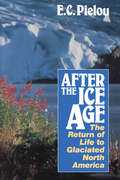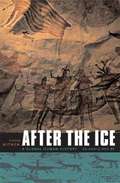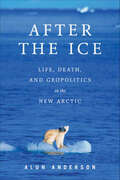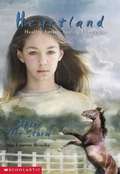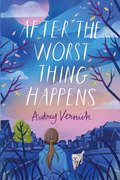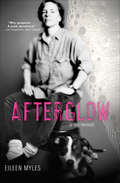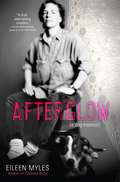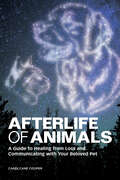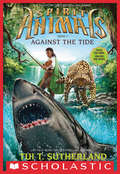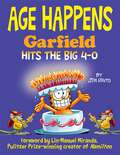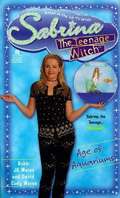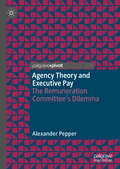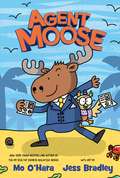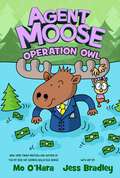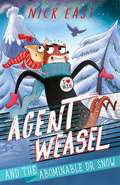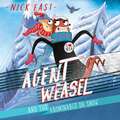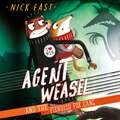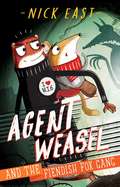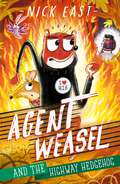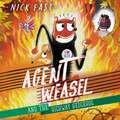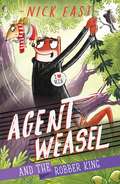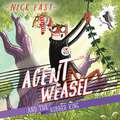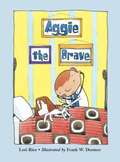- Table View
- List View
After the Ice Age: The Return of Life to Glaciated North America (None Ser.)
by E.C. PielouThe fascinating story of how a harsh terrain that resembled modern Antarctica has been transformed gradually into the forests, grasslands, and wetlands we know today.
After the Ice: A Global Human History 20,000-5000 BC
by Steven MithenArchaeology says present day humans have been on the planet for eighty thousand years. The first writing has been dated to 3,500 BC. This is what humanity may have been during from 20,000 to 5,000 BC, during the period of global warming which followed the last great ice age. The author uses archaeology to talk about humans at various times during this period of time and at various places on the planet. This book is about what life may have been like day to day over a fifteen thousand year period before we learned to write and live in cities.
After the Ice: Life, Death, and Geopolitics in the New Arctic
by Alun AndersonNew from Smithsonian Books, After the Ice is an eye-opening look at the winners and losers in the high-stakes story of Arctic transformation, from nations to native peoples to animals and the very landscape itself. Author Alun Anderson explores the effects of global warming amid new geopolitical rivalries, combining science, business, politics, and adventure to provide a fascinating narrative portrait of this rapidly changing land of unparalleled global significance.
After the Storm (Heartland #2)
by Lauren BrookeAlthough Amy is helping out with the horses at Heartland again, she still feels guilty about her mother's death. To make matters worse, she is trying to care for Spartan, the horse she and her mother rescued before the accident. For Amy, Spartan is an everyday reminder of the wreck. And Amy is a reminder for Spartan as well. Finally, Amy realizes that Spartan will never forgive her until she forgives herself.
After the Worst Thing Happens
by Audrey VernickLeft reeling after her thoughtless mistake causes a terrible accident, 12-year-old Army Morand channels her grief to help someone in need.Army Morand feels like her life has been blown to bits when the worst thing imaginable happens--her beloved dog dies. It was an accident, but it was also Army's fault. She can't seem to stop hiding from everything and everybody including her best friend JennaLouise. But then Army sees Madison, the little girl who moved in across the way, climbing a tree and walking down the street unsupervised. Her family is not neglectful, just overwhelmed. Army finds herself overcome with the need to help Madison's family to make sure another worst thing doesn't happen--which becomes even more challenging when a big storm threatens her town.After the Worst Thing Happens is a bittersweet story about a girl surprised by the force of a growing need inside her to reach out and lend a hand while trying to escape the swirling sadness of her own sudden loss. In the end, it is about finding love and hope and friendship in very surprising places.
Afterglow: (a dog memoir) (Books That Changed the World)
by Eileen Myles“A ravishingly strange and gorgeous book about a dog that’s really about life and everything there is…astonishing.” ?Helen Macdonald, New York Times-bestselling author of H Is for HawkIn 1990, poet Eileen Myles chose Rosie from a litter of pit bulls on the street, and their connection instantly became central to the writer's life and work. During the course of their sixteen years together, Myles was madly devoted to the dog’s well-being, especially in her final days. Starting from the emptiness following Rosie's death, Afterglow launches a heartfelt and fabulist investigation into the true nature of the bond between pet and pet owner. Through this lens, we witness Myles’s experiences with intimacy and spirituality, celebrity and politics, alcoholism and recovery, fathers and family history, as well as the fantastical myths we spin to get to the heart of grief.Moving from an imaginary talk show where Rosie is interviewed by Myles’s childhood puppet to a critical reenactment of the night Rosie mated with another pit bull, from lyrical transcriptions of their walks to Rosie’s enlightened narration from the afterlife, Afterglow illuminates all that it can mean when we dedicate our existence to a dog.“Myles gets at something no other dog book I’ve read has gotten at quite this distinctly: The sense of wordless connection and spiritual expansion you feel when you love and are loved by a creature who’s not human…raw and affecting.” ?Maureen Corrigan, Fresh Air, NPR
Afterglow: A Dog Memoir
by Eileen Myles<P>This newest book paints a kaleidoscopic portrait of a beloved confidant: the pit bull called Rosie. <P>In 1990, Myles chose Rosie from a litter on the street, and their connection instantly became central to the writer’s life and work. During the course of their sixteen years together, Myles was madly devoted to the dog’s wellbeing, especially in her final days. Starting from the emptiness following Rosie’s death, Afterglow (a dog memoir) launches a heartfelt and fabulist investigation into the true nature of the bond between pet and pet-owner. Through this lens, we witness Myles’s experiences with intimacy and spirituality, celebrity and politics, alcoholism and recovery, fathers and family history, as well as the fantastical myths we spin to get to the heart of grief. <P>Moving from an imaginary talk show where Rosie is interviewed by Myles’s childhood puppet to a critical reenactment of the night Rosie mated with another pit bull, from lyrical transcriptions of their walks to Rosie’s enlightened narration from the afterlife, Afterglow (a dog memoir) illuminates all that it can mean when we dedicate our existence to a dog.
Afterlife of Animals: A Guide to Healing from Loss and Communicating with Your Beloved Pet
by Candi Cane CooperConnect with and honor your animal companion with this gentle guide to the other side Losing a pet can be one of the hardest things you'll deal with. Although your companion may be physically gone, their presence is still with you every day. This exploration of pets and the afterlife is your resource for compassionate grieving and building a connection to your beloved pet even after they've crossed the Rainbow Bridge. Find tools to help you process the complex emotions of your loss and understand that however you're feeling is normal. Learn to read and interpret the different ways that your pet might be communicating with you from beyond, and find advice on how you can reach out to and honor their spirit and presence every day. Get help grieving the loss of a pet with guidance that includes: Animals of every shape and size—No matter what kind of companion you're missing, there's advice, healing, and guidance for you. Afterlife remembrance—Learn tactics that can help you value and cherish your sweet animal with little daily rituals. Rainbow Bridge FAQs—Find answers to all sorts of questions about what happens to our pets once they move on. Find comfort from your wonderful pet even after they've passed on.
Against the Tide: Against the Tide (Spirit Animals #5)
by Tui T. SutherlandThe adventure continues in this fifth book in the New York Times bestselling series.The sun is shining in the Hundred Isles, and yet the path forward seems crowded with shadows. Conor, Abeke, Meilin, and Rollan have traveled across the world, seeking a set of powerful talismans in order to keep them from enemy hands. Throughout their journey the young heroes have been hounded by pursuers, who always seem to know just where to find them. Now they know why. One of them is a traitor. As they steer the crystal blue waters of this tropical paradise, the team can't help but suspect each other. There's a spy in their midst, and before this mission is over, a deadly trap will close around them.
Agatha Parrot and the Thirteenth Chicken
by Kjartan Poskitt Wes Hargis"Chick chick chick chick CHICKEN!" Agatha and her friends are beyond excited to babysit their school’s small flock of newly hatched chicks—until they discover one of the chickens is missing! Where on Odd Street could the thirteenth chicken be?
Age Happens: Garfield Hits the Big 4-0 (Garfield)
by Jim DavisCelebrate forty years of Garfield with this lavish collection featuring classic strips, guest cartoonists, fan art, and a foreword by lifelong Garfield lover Lin-Manuel Miranda, the Pulitzer Prize–winning creator of Hamilton! The big year is finally here! Garfield, the original party animal, is aging disgracefully and celebrating wildly! Hey, what do you expect from the mischievous fat cat who is so good at being bad? Join the party, as celebrity cartoonists and fans alike pay homage to the famous feline. Even Broadway legend Lin-Manuel Miranda gets into the act by composing the book&’s foreword. This commemorative collection of birthday comic strips—plus a ton of other festive fun—is a gift for Garfield fans of all ages!
Age of Aquariums (Sabrina the Teenage Witch #20)
by Bobbi Weiss David WeissWhile cleaning up the school's new aquarium, Sabrina notices some rather unusual underwater inhabitants. Transforming herself into a tiny mermaid, she discovers the lost city of Atlantis...inside the fish tank! The great shrunken city is home to a mer-race so old it doesn't even remember its own origins. But the Atlanteans are sure that Sabrina is one of the legendary Conch Queens, come to take the city back to the Endless Waters. Sabrina wants to restore the city to its rightful place on the planet, but how can she do it without exposing her magic powers to Mr. Kraft and her mortal classmates? And what if someone doesn't want the lost city to be found?
Agency Theory and Executive Pay: The Remuneration Committee's Dilemma
by Alexander PepperThis new book examines the relationship between agency theory and executive pay. It argues that while Jensen and Meckling (1976) were right in their analysis of the agency problem in public corporations they were wrong about the proposed solutions. Drawing on ideas from economics, psychology, sociology and the philosophy of science, the author explains how standard agency theory has contributed to the problem of executive pay rather than solved it. The book explores why companies should be regarded as real entities not legal fictions, how executive pay in public corporations can be conceptualised as a collective action problem and how behavioral science can help in the design of optimal incentive arrangements. An insightful and revolutionary read for those researching corporate governance, HRM and organisation theory, this useful book offers potential solutions to some of the problems with executive pay and the standard model of agency.
Agent Moose (Agent Moose #1)
by Mo O'HaraAgent Moose, the best (worst) secret agent in the Big Forest, and his slightly-more-intelligent sidekick Owlfred are on the case in this new full color graphic novel chapter book series from Mo O'Hara, author of My Big Fat Zombie Goldfish, illustrated by Jess Bradley! Something fishy is going on at the South Shore. Folks just disappear and are never seen again. But when Agent Moose learns that a key witness has gone missing, he and Owlfred ride to the rescue. Will they find the missing turtle before time runs out?
Agent Moose: Moose on a Mission (Agent Moose #2)
by Mo O'HaraSomeone is putting the squeeze on the animals of the Big Forest, and there’s only one moose who can help in Agent Moose: Moose on a Mission, the second hilarious graphic novel chapter book from Mo O'Hara, the New York Times bestselling author of My Big Fat Zombie Goldfish! Agent Moose, the best (worst) secret agent at Woodland HQ, and his slightly-more-intelligent sidekick, Owlfred, are on the case again! There’s big news in the Big Forest! The circus is in town, Granny Moose is coming to visit, and a mysterious robber is on the loose. When Agent Moose learns that someone is putting the squeeze on innocent animals, he and Owlfred rush to investigate, with Granny along for the ride! Can they solve this mystery before any more animals face the big squeeze?
Agent Moose: Operation Owl (Agent Moose #3)
by Mo O'HaraA daring criminal is making waves in the Big Forest! It’s up to Agent Moose and Owlfred to save the day in Operation Owl, the third hilarious graphic novel chapter book from Mo O’Hara, the author of My Big Fat Zombie Goldfish, with illustrations by Jess Bradley.Agent Moose and not-quite-so-special Agent Owlfred are back and better than ever! Strange flash floods are making waves (and headlines) all over the Big Forest! Someone is pulling off particularly confounding capers and, between the flooding and the heists, Big Forest is in big trouble. When Madame HQ is nabbed right out of a very wet Woodland HQ, Agent Moose and Owlfred must wade through clues to get her back and stop the mystery criminal making a big splash in Big Forest! Can they find this fiendish villain before Big Forest floats away?
Agent Weasel and the Abominable Dr Snow: Book 2 (Agent Weasel #2)
by Nick EastMeet Agent Weasel: woodland super-spy. Can he save the Winter Whopper Games from disaster? And will there be enough marshmallows for another hot chocolate? Perfect for reading alone or sharing together, for fans of The Bolds and Toto the Ninja Cat.'I always call Agent Weasel in a crisis! I love this brilliant, funny new series.' Dermot O'LearyIt's the opening night of the Winter Whopper Games, but all is not well in the United Woodlands. Top animal athletes are disappearing, and there are whispers of a silent snow beast on the prowl. It's time to call Agent Weasel, woodland super-spy. Can he and his trusty dormouse friend Doorkins find out the secrets of Blanche, their mysterious team-mate? Will Weasel be able to compete for a golden fir cone without falling over his own feet? Will there be enough marshmallows and sprinkles for another hot chocolate? Who knows? But rest assured: even on the darkest and snowiest of nights, Agent Weasel always gets his animal. This is the second in the rib-ticklingly funny Agent Weasel series, with glorious illustrations throughout. Check out book one: Agent Weasel and the Fiendish Fox Gang.
Agent Weasel and the Abominable Dr Snow: Book 2 (Agent Weasel #2)
by Nick EastMeet Agent Weasel: woodland super-spy. Can he save the Big Freeze winter games from disaster? And will there be enough marshmallows for another hot chocolate? Perfect for listening alone or sharing together, for fans of The Bolds and Toto the Ninja Cat.'I always call Agent Weasel in a crisis! I love this brilliant, funny new series.' Dermot O'LearyIt's the opening night of the Winter Whopper Games, but all is not well in the United Woodlands. Top animal athletes are disappearing, and there are whispers of a silent snow beast on the prowl. It's time to call Agent Weasel, woodland super-spy. Can he and his trusty dormouse friend Doorkins find out the secrets of Blanche, their mysterious team-mate? Will Weasel be able to compete for a golden fir cone without falling over his own feet? Will there be enough marshmallows and sprinkles for another hot chocolate? Who knows? But rest assured: even on the darkest and snowiest of nights, Agent Weasel always gets his animal. This is the second in the rib-ticklingly funny Agent Weasel series, with glorious illustrations throughout. Check out book one: Agent Weasel and the Fiendish Fox Gang. (P)2020 Hodder & Stoughton Limited
Agent Weasel and the Fiendish Fox Gang (Agent Weasel #1)
by Nick EastMeet Agent Weasel: woodland super-spy. Can he foil the dastardly Fiendish Fox Gang once and for all? And will he still be home in time for tea and biscuits? Perfect for reading alone or sharing together, for fans of The Bolds and Mr Gum.'I always call Agent Weasel in a crisis! I love this brilliant, funny new series.' Dermot O'LearyStrange things are happening in the United Woodlands. Rabbit warrens have been peppered with itching powder. Squirrels' nuts are missing. Even Badger's bottom has been shaved! All the clues point to the Fiendish Fox Gang. It's time to call Agent Weasel, woodland super-spy. But before they can even finish their stakeout picnic, Weasel and his trusty dormouse friend Doorkins are captured by the villainous Vixen von Fluff. Can our heroes escape? Can peace be made in the United Woodlands? Will they get afternoon tea and biscuits? Does Agent Weasel have a clue what's going on? All these very important questions will be answered in this rib-ticklingly funny adventure.
Agent Weasel and the Fiendish Fox Gang: Book 1 (Agent Weasel #1)
by Nick EastMeet Agent Weasel: woodland super-spy. Can he foil the dastardly Fiendish Fox Gang once and for all? And will he still be home in time for tea and biscuits? Perfect for reading alone or sharing together, for fans of The Bolds and Mr Gum.'I always call Agent Weasel in a crisis! I love this brilliant, funny new series.' Dermot O'LearyStrange things are happening in the United Woodlands. Rabbit warrens have been peppered with itching powder. Squirrels' nuts are missing. Even Badger's bottom has been shaved! All the clues point to the Fiendish Fox Gang. It's time to call Agent Weasel, woodland super-spy. But before they can even finish their stakeout picnic, Weasel and his trusty dormouse friend Doorkins are captured by the villainous Vixen von Fluff. Can our heroes escape? Can peace be made in the United Woodlands? Will they get afternoon tea and biscuits? Does Agent Weasel have a clue what's going on? All these very important questions will be answered in this rib-ticklingly funny adventure, with glorious illustrations throughout. This is the first Agent Weasel adventure: have you checked out Agent Weasel and the Abominable Dr Snow?
Agent Weasel and the Highway Hedgehog: Book 4 (Agent Weasel #4)
by Nick EastMeet Agent Weasel: woodland super-spy. Can Agent Weasel track down the Fabulous Animal Fire Fighting Squad in time to save the Woodlands? And will he ever get hold of any more Lilac Fizz ice lollies? Perfect for reading alone or sharing together, for fans of The Bolds and Mr Gum.It's a baking-hot summer - the sun is shining, the ice lollies are melting, and there are wildfires breaking out all over the United Woodlands! The Fabulous Animal Fire Fighting Squad is the only team skilled enough to deal with such a disaster, but someone has to travel to New Pineland to alert them. But the hedge highway is a dangerous place, stalked by a spiky and dastardly foe. Can Agent Weasel track down the Fabulous Animal Fire Fighting Squad in time to save the Woodlands? Will he manage to evade the paws of the devious Highway Hedgehog? And will he ever get hold of any more Lilac Fizz ice lollies?This is the fourth Agent Weasel adventure: have you checked out Agent Weasel and the Fiendish Fox Gang?
Agent Weasel and the Highway Hedgehog: Book 4 (Agent Weasel #4)
by Nick EastMeet Agent Weasel: woodland super-spy. With wildfires breaking out all over the United Woodlands, Agent Weasel must face a new dastardly foe ... Perfect for listening alone or sharing the experience together, for fans of The Bolds and Mr Gum.It's a baking-hot summer - the sun is shining, the ice lollies are melting, and there are wildfires breaking out all over the United Woodlands! The Fabulous Animal Fire Fighting Squad is the only team skilled enough to deal with such a disaster, but someone has to travel to New Pineland to alert them. But the hedge highway is a dangerous place, stalked by a spiky and dastardly foe. Can Agent Weasel track down the Fabulous Animal Fire Fighting Squad in time to save the Woodlands? Will he manage to evade the paws of the devious Highway Hedgehog? And will he ever get hold of any more Lilac Fizz ice lollies?This is the fourth Agent Weasel adventure: have you checked out Agent Weasel and the Fiendish Fox Gang?(P)2023 Hodder & Stoughton Limited
Agent Weasel and the Robber King: Book 3 (Agent Weasel #3)
by Nick EastMeet Agent Weasel: woodland super-spy. In his greatest challenge yet, Agent Weasel must confront the villainous Rook King. Perfect for reading alone or sharing together, for fans of The Bolds and Mr Gum.'I always call Agent Weasel in a crisis! I love this brilliant, funny new series.' Dermot O'LearySpring has sprung in the United Woodlands, and the animals of Woodland Intelligence (WI6) are celebrating with a barbecue. But when a mysterious attack from the skies bursts Beaver Dam wide open, the woodland is flooded! The head of WI6 suspects foul play.It's time to call Agent Weasel, woodland super-spy. Can he manage a daring underwater rescue? Will he notice the clues leading high into the treetops? Will he ever get over the drowning of his precious biscuit collection? Find out in this wild and watery tale, with glorious illustrations throughout. This is the third Agent Weasel adventure: have you checked out Agent Weasel and the Fiendish Fox Gang?
Agent Weasel and the Robber King: Book 3 (Agent Weasel #3)
by Nick EastMeet Agent Weasel: woodland super-spy. In his greatest challenge yet, Agent Weasel must confront the villainous Rook King. Perfect for reading alone or sharing together, for fans of The Bolds and Mr Gum.'I always call Agent Weasel in a crisis! I love this brilliant, funny new series.' Dermot O'LearySpring has sprung in the United Woodlands, and the animals of Woodland Intelligence (WI6) are celebrating with a barbecue. But when a mysterious attack from the skies bursts Beaver Dam wide open, the woodland is flooded! The head of WI6 suspects foul play.It's time to call Agent Weasel, woodland super-spy. Can he manage a daring underwater rescue? Will he notice the clues leading high into the treetops? Will he ever get over the drowning of his precious biscuit collection? Find out in this wild and watery tale, with glorious illustrations throughout. This is the third Agent Weasel adventure: have you checked out Agent Weasel and the Fiendish Fox Gang? (P)2021 Hodder & Stoughton Limited
Aggie The Brave (Aggie and Ben)
by Frank W. Dormer Lori RiesThey met and became best friends in AGGIE AND BEN. They learned to behave in GOOD DOG, AGGIE. Now Aggie and Ben must conquer their fears in their third book for beginning readers. Aggie has to go to the vet, but it’s Ben who needs to be brave as he deals with a night without his best friend. When Aggie returns home, she is unable to play. Ben must do his best to take care of her and make her feel better.
